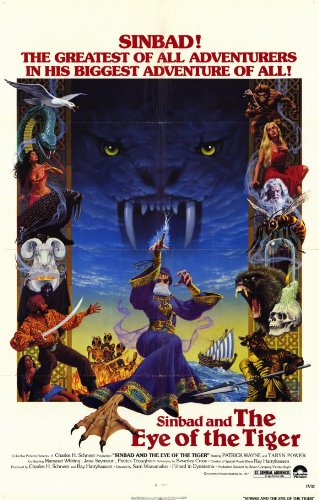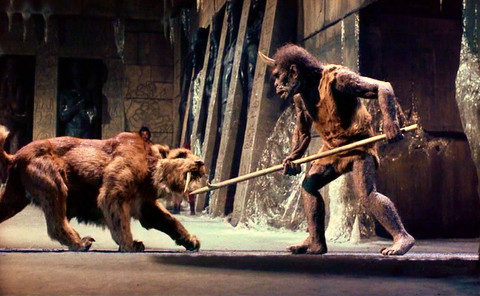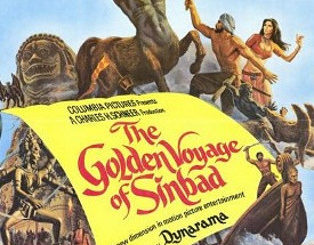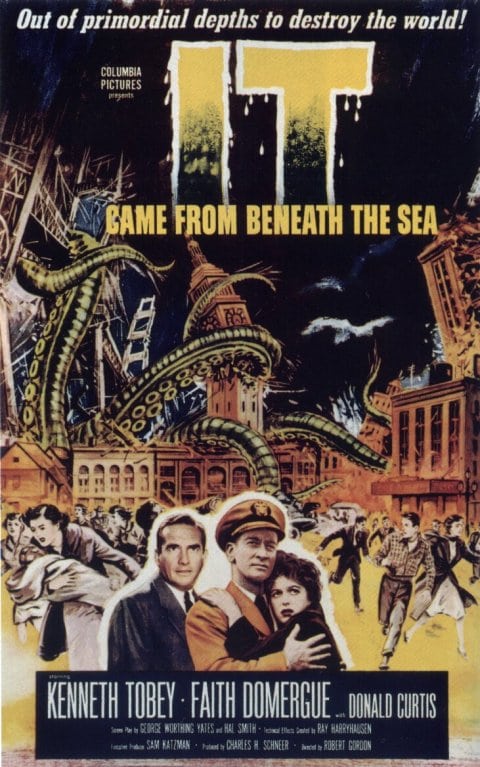Sinbad And The Eye Of The Tiger (1977)
Directed by: Sam Wanamaker
Written by: Beverley Cross, Ray Harryhausen
Starring: Jane Seymour, Margaret Whiting, Patrick Wayne, Taryn Power
UK
AVAILABLE ON BLU-RAY AND DVD
RUNNING TIME: 113 mins
REVIEWED BY: Dr Lenera, Official HCF Critic
Prince Kassim is transformed during his coronation as Caliph of the city of Charak into a baboon by his stepmother, the witch Queen Zenobia, who wants the throne for her own son, Rafi. The Prince’s sister, Princess Farah, seeks the help of her betrothed, Sinbad. It seems that the only person who may know how to cure Kassim is a Greek sage called Melanthius, who tells them they need to journey to the North Pole and the Shrine of the Four Elements, which has a powerful force that can turn Kassim back into a human. Time is of the essence though, because after seven moons have passed Kassim must renounce the Caliphate, and Zenobia and Rafi are trying to beat Sinbad to the Shrine..…
So Harryhausen fans are divided on whether The 7thVoyage Of Sinbad or The Golden Voyage Of Sinbad is the better film, with a few more in favour of the former film. However, I can’t imagine that there are many who would make a claim for Sinbad And The Eye Of The Tiger being the best of the three. Whenever I watch it, which is usually soon after I’ve watched the first two though not as often, I always hope that it will come across as much better than I remembered it, but that is yet to happen! It has some good stuff in it and overall still just about passes muster as a fantasy adventure, but a great many flaws hold it back, first and foremost being that it is very slow moving, even towards the end where the pace should be ramping up which is what The Golden Voyage Of Sinbad did with considerable success. At one point in it somebody says; “Captain Sinbad, is there no way of speeding this thing up?”, something that many viewers also probably ask. At least 20 minutes worth of footage could be removed with no harm done to the story and other scenes could be significantly tightened with considerable improvement resulting, though problems with the script, acting, and – I hate to say this – the special effects would still remain. Harryhausen has admitted that things were rushed to make the release date. Just about enough good examples of his artistry remain to just about make watching it worthwhile, but it often looks oddly cheap despite it having nearly three times of budget of the previous film. What makes it so disappointing is that, if you think of the basic elements, it could very well have been the best of the lot, but something clearly went a bit wrong here.
It was put into production straight after the success of The Golden Voyage Of Sinbad, which could be one reason why it’s a little lacking. John Phillip Law was set to return as Sinbad but was never asked, a mystery which Harryhausen fails to answer satisfactorily in his book ‘An Animated Life’. Utilising the dropped concept from the previous film of a man turned into a baboon and borrowing much from Greek mythology, Harryhausen wrote an outline which went through several treatments with titles like Sinbad Beyond The North Wind and Sinbad At World’s End, the title they should have used because the one they did makes little sense. Dropped ideas included a valley of vipers [this had originally been planned for The 7th Voyage Of Sinbad], a large worm [this became a large mosquito], a whole family of Troglodytes which was cut down to just one primitive ‘man’, and the main Troglodyte battling an Arsinoitherium [prehistoric rhinoceros]. The Giant Walrus was originally going to be a Yeti, then a woolly Mammoth. Cut from the final script was an elaborate sequence, which would have been amazing going by Harryhausen’s sketches, showing the creation of the Minoton [metal Minotaur].This would have been a wild variation on the archetypal creation scene from Frankenstein movies, replete with much scientific equipment and demonic assistants. The Minoton was originally going to be a person in a suit, and some shots with a certain Peter Mayhew playing the creature remain in the film. Shooting took place in Spain, Jordan and Malta. Despite what some claim, it was a reasonable hit at the box office despite being overshadowed by a certain George Lucas picture that came out a few months before.
The film gets off to a decent start with Kassim being transformed, though into what we don’t see for some time, Farah’s scream being enough for now. Already it’s apparent that we’re leaning more towards The 7th Voyage Of Sinbad, bringing back much brightness and strong colour. In fact, you could say that the costumes are often too bright, with Sinbad looking rather silly sporting a charisse pink cloak and later on a virtually a whole orange outfit. It’s certainly pleasing to the eye though and enhances the fairy tale feel. Much like the 1958 film we almost immediately get a special effects/action sequence, after a brief sword fight with some surprisingly fast cutting for a film of the time. Seeing as editor Roy Watts doesn’t do this anywhere else in this or the previous episode which he also worked on, one can reasonably assume that this was done out of necessity. Sinbad then battles three Ghouls sent by the witch Zenobi, which are basically the skeletons from The 7th Voyage Of Sinbad with faces like the Selenites from First Men In The Moon. It’s a solid sequence though there’s some poor editing, something that hampers the film throughout and is another sign that things were rushed. Sinbad’s first port of call is Melanthius’s island, and we get to see the truly stunning location of Petra, Jordan, where lots of buildings are carved into the sides of mountains, and which will be recognisable to fans of Indiana Jones And The Last Crusade. There seems to be much building up to a major scene, but all we then get are few seconds of people throwing rocks, after which we [very slowly] get into Melanthius’s house and listen to some very wordy exposition which could have easily been simplified before our group plus Melanthius set off for the North Pole. But of course Zenobia and Rafi are trying to get there first to stop them, their boat propelled by the Minoton, basically an ancient robot.
A large bee on the ship, created accidentally by Melanthius when he stupidly [for a sage he’s pretty dumb throughout] decides to test the potion that enabled Zenobia to transform into a gull [a moment weakly done by bleaching sections of the negative] and then a tiny human, creates a modicum of excitement. Then a bit later we get the Giant Walrus attacking the group, though this is partially blurred by loads of fake snow that never seems to fall on the cast members, maybe done to try to hide the fact that it changes size in places. The Troglodyte is a likable creation, though perhaps Harryhausen’s most touching character out of all his movies is the Baboon that was formerly Kassim. While it never really convinces us adults now as a real baboon, I’m sure it may have fooled some kids when it came out. It interacts with the humans very well and you really feel for this human-turned-animal who’s gradually losing his human characteristics. The Minoton is, disappointingly, accidentally killed off, but you do eventually get, after Zenobia has bizarrely ordered her son very loudly to kill the Baboon when several sword-wielding toughs are around him, a Sabre-Toothed Tiger [Smilodon] which battles the Troglodyte in what is the best of Harryhausen’s monster battles; agile, thrilling and a bit longer than the others. Here, the Harryhausen magic is in full swing, despite an instance of weak editing where we cut from the combatants to the humans for a second, then back to the monsters and they’re in a totally different position. But the most jarring thing in the film is the large amount of footage involving back projection of the lead performers who it seems never went on location at all. Some instances aren’t too bad, but then you also get lengthy portions of people wondering about with bright blue outlines, and stand-ins that even at a distance don’t much resemble the performers. In one group of shots, Farah is wearing a blue dress instead of the green one that she should be sporting. I’m surprised that all this was thought to look satisfactory, especially considering the very good footage of the tiny Zenobia which include a flawless shot of her in a jar with people looking at her. And you’d never know that the power source of the shrine of Arimaspi is actually – dental floss, being revolved around and pulled out of focus. Oh the ingenuity of old school special effects!
There’s good work in this one without a doubt, but a surprising amount of sloppiness too. Director Sam Wanamaker, an actor who occasionally helmed features, can be partly blamed for the plodding pacing of the film which never gathers any momentum. Even towards the end, people slowly walk about and then seem to stand around for ages waiting for something to happen. While certain key scenes are rushed and even look like bits are missing, other, less important bits just go on forever. Dialogue is mostly mediocre [this is easily the weakest of Beverly Cross’s three Harryhausen scripts], though it’s rather a shame that you probably wouldn’t get the line; “you know I’ve never seen a black man turned white before” in today’s uptight PC climate. But there is a much greater variety of terrain here which is pleasing, and it’s nice to have a female villain this time around. Margaret Whiting delivers her dialogue in a strange accent which isn’t really Arabic but is certainly effectively uncanny, yet you actually feel for her when Melanthius is torturing her with bee venom [for a good reason, of course], and right at the end. But Patrick Wayne, John’s son, is just appallingly lacking in charisma and delivers many of his lines in a dull monotone, while another old-time star’s sibling, Taryn [daughter of Tyrone] Power fares little better. At least Jane Seymour looks at her most glamorous, and even shows a touch of breast when her and Power skinny-dip. And it’s amusing to see Kurt Christian, who was one of Sinbad’s men in The Golden Voyage of Sinbad, switch sides and play Zenobia’s evil son Rafi.
Roy Budd’s score is solid, with a nice sweeping main title theme conjuring up the romance of the Orient and a catchy little tune for the Baboon, though he doesn’t give Harryhausen’s creatures that extra dimension that Herrmann and Rozsa did, going more for conventional action scoring, and those two luminaries would have probably lifted the rest of the film a bit with their efforts. I’ve probably sounded too harsh on Sinbad And The Eye Of The Tiger unless you’ve actually seen it, and have probably surprised some readers by being this way about it. I can’t say I’ve enjoyed writing this review much. But then I’ve spent a lot of time praising Harryhausen’s work over the years, and he probably can’t be blamed to any great extent for the way things were obviously hurried in the film [I’m sure he did his painstaking best with the time that he had] and the other defects. I do think that some judicious pruning would improve it somewhat, though it might be more a case of tightening lots of scenes rather than totally removing some. It still retains a charm and innocence that, despite its many issues, make it almost impossible to actually dislike.











I’m watching it again right now. I think you’re completely fair here. I’m taking a break in the middle, and looking around online, this is the single BEST review of the film I’ve found.
Elsewhere, I read that Charles Schneer had worked with Sam Wanamaker on another film and hired him with the idea he was an “actor’s director” and could help flesh out cardboard characters. But when I compare “TIGER” to “GOLDEN”, it appears he did the EXACT opposite!
While Zenobia is memorable, she is a CARTOON character of a villain. (She also reminds me a HELL of a lot of my late best friend’s mother, who was a BEAST on 2 legs.) Meanwhile, Schneer himself (who cast both Wayne & Power) said Wayne was “merely adequate”. I’ve always thought so… UNTIL I saw Wayne in “THE PEOPLE THAT TIME FORGOT”, which came out the same year. Well, gee, somehow Kevin Connor– who the 2 Amicus producers felt was “the best director they ever worked with”, managed to bring out a VASTLY-superior performance from Patrick Wayne in a far-lesser film, again, THE SAME YEAR. I think we can pin the blame squarely on Wanamaker, who should have stuck to acting.
Seeing this in theatres twice when it came out (I only went to see “STAR WARS” once that year), I thought it was “okay”, but nowhere near as good as “GOLDEN”, and for the life of me, I could not imagine why John Phillip Law– or ANYONE from the previous film, was not brought back. Except, of course, for Kurt Christian, who was such a delight as the drunken merchant’s son who tried so hard to better himself, and succeeded. Here he’s just a spoiled rich kid who comes to a bad end due to his evil mother.
Thank you greatly for the compliment! Yes, it certainly seems that Sam Wanamaker was the main person responsible for holding this film back. God, I haven’t seen any of the four Amicus ‘lost world’ films in about 30 years….now seems like a good time to check them out again, I’m sure they’ll provide some fun, even though the special effects side of things may seem lacking compared to what Harryhausen was able to accomplish.
I agree that this is a very fair review. It feels like S-EotT had a lot of elements that when put together should be been a fine addition to the franchise, but none of them really mesh together into a coherent whole that’s fun to watch. The pacing really did need better editing, but it sounds like they didn’t take the time to do that to the degree necessary. This is perhaps the one Sinbad movie from the period that if I see it on TV on a lazy Saturday afternoon, I’ll watch for about 10-15 minutes then get reminded why I never really found it fun or especially interesting. I don’t know if it could have been salvaged if they’d brought John Phillip Law back, but it certainly would have been an improvement at least.